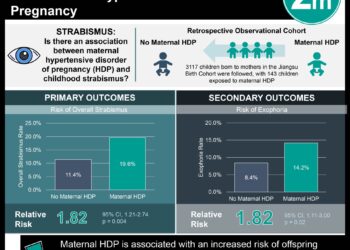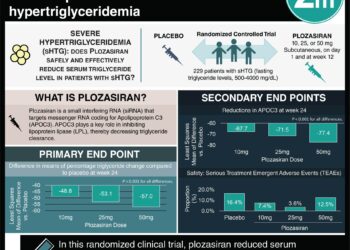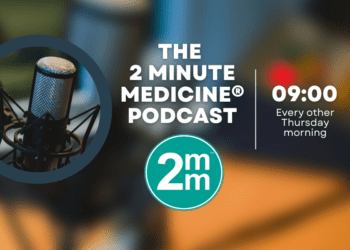RNAi suppression of sFLT1 for preeclampsia treatment [PreClinical]
1. The clinical manifestations of preeclampsia result largely from excess circulating soluble vascular endothelial growth factor receptor (sFLT1), produced by the placenta.
2. Designer short interfering RNAs (siRNAs) that target particular sFLT1 mRNA isoforms were shown to accumulate in the placenta and prevent the hypertension and proteinuria associated with preeclampsia.
Evidence Rating Level: 2 (Good)
Study Rundown: Preeclampsia, a condition during pregnancy involving new-onset hypertension with end organ dysfunction, complicates approximately 1 in 10 pregnancies and results in the death of thousands of infants and women each year. Women with preeclampsia develop hypertension, often with proteinuria, after the 20th week of pregnancy. Maternal complications include kidney injury, HELLP (hemolysis, elevated liver enzymes and low platelets) syndrome, transaminitis, pulmonary edema, and stroke, while fetal complications can range from intrauterine growth restriction to neurologic injury and death. Currently, the only treatment for preeclampsia is fetal delivery.
Over the past several years, several studies have associated preeclampsia with abnormally high levels of circulating sFLT1 proteins. sFLT1 proteins are secreted by the placenta and disrupt normal endothelial function and angiogenesis by scavenging circulating vascular endothelial growth factor receptor (VEGF), resulting in attenuation of VEGF signaling. Additional evidence has suggested that sFLT1 is not only associated with, but also directly contributes to the pathogenesis of preeclampsia; apheresis of maternal blood to lower circulating factors such as sFLT1 partially ameliorates hypertension and proteinuria.
As both a marker and likely causative agent of preeclampsia, sFLT1 represents a promising target for pharmacologic intervention. A recent study made several advances in this area. First, by transcriptional profiling of sFLT1 and FLT1 mRNAs in normal and preeclamptic placentas, it was determined that certain sFLT1 mRNA isoforms are predominant in the placenta and upregulated in the context of preeclampsia. These sFLT1 isoforms had unique 3’ ends, which offered the opportunity to selectively target sFLT1 mRNAs using siRNAs. Second, the authors determined how to chemically modify sFLT1-targeting siRNAs to allow placental accumulation. The modification strategy was based off prior work suggesting that hydrophobic conjugation favors tissues with high blood flow and fenestrated endothelium, including the placenta. In mice, designer sFLT1-targeting siRNAs were shown to accumulate substantially in the placenta (~7% of injected dose), but less so in other maternal or fetal tissues. These siRNAs reduced sFLT1 concentrations by up to 50%. In a baboon model with a more human-like physiology, a single injection of targeting siRNAs reduced sFLT1 concentrations and suppressed clinical signs of preeclampsia, including hypertension and proteinuria.
This report represents a promising possible therapy for preeclampsia. Successful translation of sFLT1-targeting siRNAs will require further interrogation of potential off-target effects of the siRNAs. Furthermore, extending the duration of the therapy and preventing possible side effects will require strategies to maximize the selective accumulation of siRNAs in the placenta.
Click here to read the study in Nature Biotechnology
Relevant Reading: Molecular mechanisms of preeclampsia
In-Depth [pre-clinical study]: The objective of this study was to develop siRNAs targeting sFLT1 for the treatment of preeclampsia. A screen first identified siRNAs that selectively silence sFLT1 mRNA isoforms. Two of these isoforms – sFLT1-i13 long and sFLT1-e15a – contain nucleotides not present in the full-length FLT1 mRNA, allowing selective targeting. Panels of siRNAs respectively were screened for each isoform in an in vitro luciferase reporter assay, and the silencing activity of the top candidates were confirmed in human primary cytotrophoblasts, the placental cell type responsible for sFLT1 expression.
Hydrophobically modified siRNAs (hsiRNAs) were chemically stabilized for systemic, conjugate-mediated siRNA delivery. The passenger strand of the hsiRNAs was labeled with a Cy3 fluorescent dye to visualize the extent of tissue delivery in vivo. Cy3-labeled hsiRNAs were injected into pregnant mice at gestational day 15, and tissues were collected 24h after injection and examined by fluorescent microscopy. The siRNAs were found to accumulate mainly in liver, kidneys, spleen and placenta, consistent with the hypothesis that the modified conjugated siRNAs accumulate preferentially in tissues with high blood flow and endothelial fenestration. The Cy3-labeled siRNAs were shown to label only the placental labyrinth with no detectable uptake by other cell types in the decidua. A novel hybridization assay was used to quantitate guide strand levels in different tissues, confirming accumulation in the placenta (10-20 ng/mg) but not in other fetal tissues (<0.05ng/mg). The silencing ability of the hsiRNAs was confirmed in vivo, and safety of the siRNAs was determined to be adequate. There were no significant effects on pup viability, weight, or ability to thrive, and no change in maternal liver enzymes or placental vascularization.
The designer hsiRNAs were further tested in a baboon model of preeclampsia. In this model, uteroplacental ischemia (UPI) was induced by ligation of a single uterine artery at gestational day 133, reducing placental blood flow by ~30% and causing a spike in sFLT1 levels and maternal hypertension and proteinuria. A single injection of purified hsiRNA one hour after induction of UPI was administered and animals were monitored for 2 weeks. Treated animals (n=6) demonstrated a potent reduction in circulating sFLT1 protein compared to control animals (n=3), though the kinetics of sFLT1 reduction were variable. Offspring of baboons that had been treated with hsiRNAs had lower birth weights, suggesting a possible systemic pharmacological side effect of the treatment.
Image: PD
©2019 2 Minute Medicine, Inc. All rights reserved. No works may be reproduced without expressed written consent from 2 Minute Medicine, Inc. Inquire about licensing here. No article should be construed as medical advice and is not intended as such by the authors or by 2 Minute Medicine, Inc.







